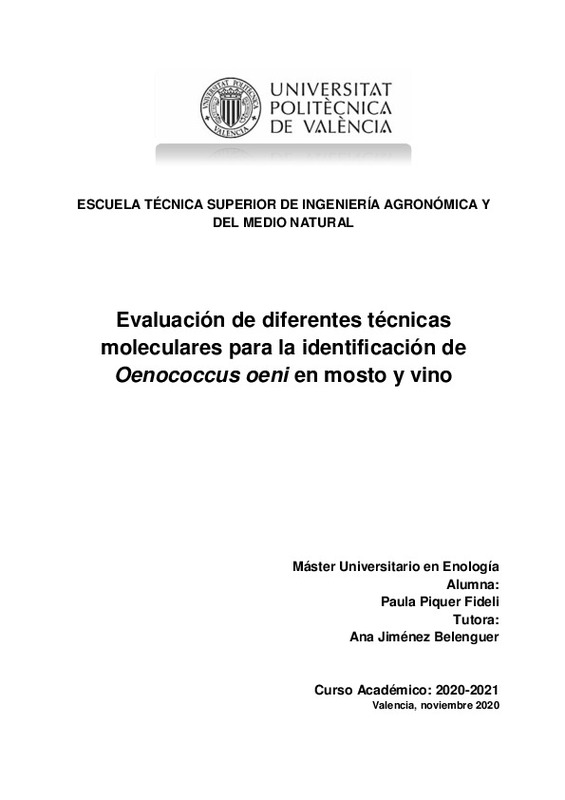|
Resumen:
|
[ES] La comunidad de microorganismos utilizados en la elaboración de vino es muy diversa. Este trabajo se va a centrar en la especie Oenococcus oeni. Oenococcus es un género de bacterias Gram positivas, dentro del cual se ...[+]
[ES] La comunidad de microorganismos utilizados en la elaboración de vino es muy diversa. Este trabajo se va a centrar en la especie Oenococcus oeni. Oenococcus es un género de bacterias Gram positivas, dentro del cual se encuentra la bacteria más conocida, Oenococcus oeni cuya misión es llevar a cabo la fermentación maloláctica que aporta una composición, color y unas características organolépticas que definen la calidad en muchos vinos, especialmente en los tintos.
El vino presenta una dinámica microbiana diversa que cambia desde el mosto hasta transcurrir la fermentación alcohólica y maloláctica. En los últimos años, se han desarrollado técnicas moleculares que permiten identificar los microorganismos en el vino para controlar el proceso de vinificación y así obtener el vino deseado. En este trabajo se van a evaluar las principales técnicas moleculares para la identificación de Oenococcus oeni y su identificación frente a las demás bacterias en el vino.
En este estudio se han descrito las principales técnicas moleculares divididas en dos apartados, el primero para la identificación de la bacteria Oenococcus oeni como especie y el segundo para la identificación de sus cepas. Cada apartado a su vez se ha dividido en tres secciones según se realizaba el análisis completo o parcial del genoma bacteriano. Para la identificación a nivel de especie se ha expuesto las técnicas de FISH, 16S-ARDRA, DGGE, PCR especie-específica y a nivel de cepa se ha puntualizado las técnicas de MLST, ITS-PCR, AFLP, RAPD y PCR en tiempo real.
Los estudios más recientes han demostrado que el PCR en tiempo real tiene muchas ventajas respecto a la PCR tradicional para la identificación a nivel de especie y cepa de la bacteria Oenococcus oeni.
[-]
[EN] The community of microorganisms used in winemaking is very diverse. This study is focussed on Oenococcus oeni species. Oenococcus is a genus of Gram positive bacteria, which is the best-known bacterium, Oenococcus ...[+]
[EN] The community of microorganisms used in winemaking is very diverse. This study is focussed on Oenococcus oeni species. Oenococcus is a genus of Gram positive bacteria, which is the best-known bacterium, Oenococcus oeni whose mission is to carry out malolactic fermentation that provides a composition, color and organoleptic characteristics that define the quality of many wines, especially red ones.
The wine presents a diverse microbial dynamics that change from the must to the alcoholic and malolactic fermentation. In recent years, molecular techniques have been developed that allow the identification and control of microorganisms in wine to control the winemaking process and thus obtain the desired wine. In this project the main molecular techniques for the identification of Oenococcus oeni and its identification against the other bacteria in wine will be evaluated.
In this study, the main molecular techniques are divided into two sections have been described, the first one for the identification of the bacterium Oenococcus oeni as a species and the second one for the identification of its strains. Each section has also been divided into three sections according to the complete or partial analysis of the bacterial genome. For the identification at species level, the techniques of FISH, 16S-ARDRA, DGGE, species-specific PCR have been exposed and at strain level the techniques of MLST, ITS-PCR, AFLP, RAPD and real-time PCR have been specified.
The most recent studies have shown that real-time PCR has many advantages over traditional PCR for the species and strain level identification of the Oenococcus oeni bacterium.
[-]
|







